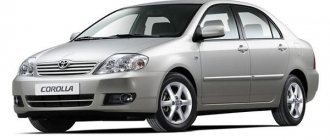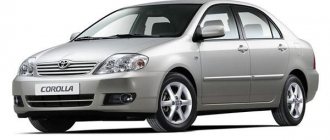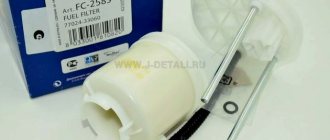Features of work
The fuel pump in the Toyota Corolla, which is found on most models with a 120, 140 and 150 body, works on this principle: at a given point in time, a fuel-air mixture is injected in certain proportions and volumes into the engine. This happens through the injector nozzles. The combustion of the mixture occurs after ignition by a spark from the candles.
Unlike carburetor engines, which were no longer installed on the Corolla since 1998, there is a saving in fuel consumption and an increase in traction power by 10%. It also ensures maximum reduction of harmful substances in exhaust gases entering the atmosphere.
An injection engine requires a more careful approach (such units are installed on Toyota Corolla models 120 and 150) both in maintenance and repair. Therefore, replacing the fuel pump and carrying out repair work, its removal and installation, if possible, should be carried out at a service center.
In addition to ensuring the supply of fuel to the engine, the pump regulates the required optimal pressure level in the fuel supply system.
content .. 26 27 28 29 ..Toyota Corolla E150 (2010+). Why is the fuel pump humming?
The electric fuel pump on cars with an injector is a submersible fuel pump that is installed directly in the gas tank. Structurally, such a pump is an electromechanical device that takes fuel from the tank and supplies it to the engine. The task of the fuel pump (BN) is to pump fuel into the fuel line. As a result, the necessary pressure is created in the fuel rail for subsequent injection of gasoline using injection nozzles.
The list of common faults includes the following:
- the fuel pump hums/whistles; - the fuel pump gets very hot; - the fuel pump does not turn off;
Let's look at the main reasons why these problems occur, and also consider the available ways to check the fuel pump yourself.
The fuel pump whistles and hums
Let's start with the fact that the proper operation of the fuel pump involves a certain noise or soft humming sound after turning the ignition key. In other words, the fuel pump hums while it creates operating pressure in the line. This process lasts 2-3 seconds, after which the driver can hear a slight click. This click is produced by the fuel pump relay.
Note that many drivers of cars with mileage of 100 thousand km or more. and more note a slightly increased noise level from the fuel pump. The fuel pump may hum or whistle louder when you turn the ignition key. At the same time, there are no problems with engine starting, fuel consumption and smooth reactions to pressing the gas pedal while driving. The car practically does not lose any dynamics, allowing you to drive with a humming gas pump for tens of thousands of kilometers.
In case of such pump problems, it is advisable to carry out diagnostics, since constant operation with an increased load causes overheating of the fuel pump and reduces its service life. However, you should not immediately change the pump without checking it. Replacing the fuel pump mesh and fuel filter, as well as cleaning the injectors, in many cases allows you to get rid of noise. A stronger or progressive whistle and hum of the fuel pump is a reason to immediately identify and eliminate the breakdown, which involves checking the functionality of individual elements of the engine power system. In this case, increased noise level of the fuel pump usually occurs for the following reasons:
dirty fuel filter and fuel pump strainer; the fuel line is clogged; the fuel pump motor fails; fuel injectors are clogged; the pressure regulator in the fuel rail is faulty;
These malfunctions are also often accompanied by poor engine starting, unstable operation of the internal combustion engine (the engine troits) at idle and under load. There were jerks, dips and delays in the engine's response to pressing the accelerator. In such a situation, the car becomes difficult and even unsafe to operate, since you can suddenly stall or get into an emergency situation when trying to overtake.
The fuel pump is very noisy: troubleshooting
In most cases, an increase in noise level occurs due to an increasing load on the gas pump, which becomes more difficult to pump the required amount of fuel. Overheating or failure of the pump itself is less common.
At the initial stage, it should be understood that if the gas pump makes a sound (albeit different from normal), then power is supplied to the device and the pump itself reacts to the supply of electricity. Based on this, the problem can be localized faster. Before diagnostics, it is recommended to replace the fuel filter to eliminate the possibility of a decrease in throughput in this area.
To start checking the fuel supply pump, you need to measure the fuel pressure in the fuel rail with a pressure gauge. The average pressure is considered to be 3 atmospheres. This method allows you to accurately assess the performance of the fuel pump. There is also a simple solution that allows you to quickly check the status of your device. The method involves removing the return hose and inserting it into a separate container suitable for pouring gasoline. Next, you need to measure how much fuel is drained back into the tank. The norm for many gas pumps is a minimum value of 1.5 liters per minute or more. The disadvantage of such measurements can be considered very approximate readings, which do not allow obtaining accurate data.
If the check shows that the pump does not produce the required pressure or constantly works to maintain it, then you need to change or clean the fuel pump strainer. To do this, you will need to remove the fuel pump, which is usually located in the rear of the car under the seat. Please note that on cars that have been in use for a long time, in parallel with replacing the mesh, it is necessary to wash the gas tank itself. The fact is that dirt and deposits will quickly damage the new filter.
After replacing or cleaning the pump filter, you should also check the pressure regulator in the fuel rail and clean the injection nozzles. In most cases, these procedures can reduce the noise level or almost completely eliminate the whistling and hum of the fuel pump. If the pump continues to make noise, then there is a high probability that the pump motor needs to be replaced.
Replacing the fuel pump motor
The reason for replacing the fuel pump module motor is low gasoline pressure or sudden changes in pressure, which is recorded by a pressure gauge during the diagnostic process. Also, the imminent failure of the motor is indicated by the fact that the fuel pump is humming or whistling.
In this case, it is often possible not to change the pump assembly, which will save money. The device must be removed (similar to the situation with cleaning or replacing the mesh filter), after which it is disassembled. The motor itself is replaced and can be purchased separately. The housing and fuel level sensor can be left from the old fuel pump. At the same time, it is recommended to replace the gas pump gasket and other rubber seals, which are not designed for re-installation after removal, that is, they are disposable.
The fuel pump does not turn off and overheats
One of the common malfunctions is that after turning the ignition key, the fuel pump does not turn off, that is, it hums constantly. In the list of the main reasons, auto electricians highlight:
burning (sticking) of the contacts of the controlled circuit of the fuel pump relay; short circuit in the electrical wiring to the pump; Less commonly, a malfunction of the ECU or the pressure sensor on the pump occurs (which depends on the fuel pressure device of a particular vehicle), which also forces the fuel pump to work constantly. Another reason could be injectors that are “pouring”, which does not allow the pump to create pressure in the rail and start the engine. You can check the condition of the spark plugs. If the spark plugs are flooded, then you should check the injector chain for a break.
The fuel pump relay is quite easy to check. A working element in a working system clicks after 3-5 seconds. after turning on the ignition, after which the pump turns off. If the relay does not make a click or there is a click but the pump does not turn off, then you need to remove the relay. Stopping the pump will indicate that the specified relay has failed. You can also take out the relay and lightly tap it, while simultaneously removing the terminal from the battery. This method often solves the problem of a stuck fuel pump relay. Now a few words about pump overheating. If the fuel pump on the injector overheats, this manifests itself in a decrease in its performance and unstable engine operation. The electric fuel pump itself is submersible, that is, it is located in the fuel tank directly in the gasoline. This arrangement allows the device to effectively cool itself in the fuel. A low fuel level below 1/4 tank during active vehicle operation in high outside temperatures can cause such overheating.
content .. 26 27 28 29 ..
Causes of malfunction
You can suspect a malfunction of the fuel pump of a Corolla 120 or 150 body based on the following characteristic signs:
- A decrease in engine power, which occurs due to wear of the fuel pump and requires its replacement.
- The engine does not start well even after proper warming up. This occurs due to the wear and tear of the valve that maintains the pressure in the system at the required level, or the gas tank mesh may be dirty, which can be removed and cleaned or simply replaced.
- Jerky movement can also be caused by both wear of the pump elements and third-party contamination.
- The engine often stalls and stalls.
- Extraneous noises during engine operation.
The presence of these malfunctions is a reason to seek help from a service station to receive qualified assistance, which usually begins with diagnostics (high-quality diagnostics are carried out using Bosch equipment). Most often, when the components wear out, the fuel pump is replaced, as well as consumables that ensure its uninterrupted operation.
Other causes of fuel pump malfunction include:
- Low quality fuel, as well as the presence of impurities, dust and water in it.
- Accumulation of condensate in the gas tank due to temperature changes.
- The habit of driving with a tank less than half full of gasoline.
- Dirty fuel filters.
You can choose the right fuel pump if you know exactly the make and model of the engine.
Where is the fuel pump located
When faced with the need for repair or replacement for the first time, many car enthusiasts ask where the fuel pump is located. The pump is located directly in the gas tank and is in direct contact with the fuel, that is, it is immersed in gasoline. On most civilian vehicles, the gas tank is located at the rear of the vehicle under the floor.
The fuel pump is installed so that it is located at the top of the gas tank. Thanks to this placement, the pump can be accessed directly from the cabin. To do this, you need to remove the rear sofa, since the fuel pump is located directly under the seat on the left or right side.
Rules for removal and replacement
It is necessary to remove the fuel pump in models with a body size 120 and above after first removing the rear seat. It is under it that there is a hatch for the gas tank, under which you can find the fuel module along with the fuel line. There is also a power supply connector for the fuel system.
Dismantling the fuel module must be done very carefully to prevent damage to the plastic housing and fasteners. The module is removed after being completely disconnected from the fuel line and disconnected from the electrical connector.
Quite often, the cause of incorrect operation of the fuel pump can be a clogged mesh of both the coarse filter and the fine filter. This involves replacing the pump and all filters included with it.
Before installing the fuel pump for Toyota Corolla 12 and above, it should be checked on a diagnostic stand along with the entire complex involved in supplying fuel to the engine.
After the verification procedure, the module is installed and connected to the mains. It is necessary to monitor the quality of installation of sealing elements - sealing rings and gaskets, which are responsible for the penetration of excess air into the system. After this, the rear seat is installed in place. Timely diagnostics, high-quality maintenance and proper operation are the key to efficient operation of not only the fuel pump, but also all vehicle systems as a whole.
Selecting a fuel pump for TLK 200
The device must be replaced with an original brand from the Toyota manufacturer. But, if the car owner cannot find the required fuel pump, then it is temporarily possible to install a replacement from the following companies:
- Bosch;
- Denso;
- Pajero.
Analogs of the fuel pump for the Land Cruiser 200 (petrol or diesel) can be installed temporarily. For regular use, it is recommended to use Toyota mechanisms so as not to have problems with the engine in the future.
see also
Comments 42
It drives with dips, sometimes, especially when switching, as if it’s then normal. I drove like this for about a month, then the pump died. I was traveling with my family from the dacha and stopped. I remove the supply to the injector and there is horseradish and not pressure. They pulled me home, took off the pump, went straight to him and it sprayed into me, but he was dying right before my eyes. Stelox did not take bad reviews. I took another one, but it’s also from China, I’ll post it a little later
It buzzes and holds you by the ass, didn’t finish it off, replaced it with Pirburg (it was GP). The mesh was knocked out, when I removed the hose, gasoline poured into the sleeve :)
And it started gushing, I replaced the pump and filter, by the way it didn’t bleed the filter
How is it that it wasn't blown through?
I blow into the new one, I’m sulking, I drained everything from the old one and I can’t blow it))
Have you installed everything? Works?
Yes, the girl went, I’ll go myself in an hour, I’ll see if she went faster)))
What pump did you install?
I got it from China, Stelox, it was very cheap, and I wasn’t sure what the problem was... Before that there was tech ass, also from China
For a while, maybe longer, it’s like a lottery :)
Everything will be fine))) our gasoline is better than yours
Cherkani then lives like a pump.
Remind me in PM like a thread
Measure the pressure at the “wall”
remove the hose that goes from the gas tank to the pump; if the gas flows poorly, pierce the mesh in the tank. If it’s not pierced, then it’s clogged anyway
everything is fine with this
I came across something that stalls when hot and does not start, sits for about 5 minutes and starts with half a push, I changed the pump.
You give it gas and it feels like your ass is being pulled.
It would be good to check the pressure in the ramp)
It took it from me and stopped working))
Check the performance of the pump. Connect directly to the 12V pump and 650 grams of gasoline should flow out in 30 seconds. Remove the outlet hose from the pump.
I won’t write any more, turn off the feed and check the flow. Then conclusions.
Oh well. I wasted my time.
I won’t write any more, turn off the feed and check the flow. Then conclusions.
I have a supply hose from the tank 2 cm in diameter, when I removed the pump and plugged it up a little, gasoline poured out of a tap. This is a convertible
bad morning start - “cold”, “sluggish” gas pedal, poor acceleration...
Great in the morning, the pedal is sluggish
Humming is not a sign. Are we talking about v3? For the first time I howled - I thought about changing it. But - in the pit we remove the supply to the pump - if the trickle is barely there, then there is water in the tank. It does not pass through the mesh and does not supply gasoline.











